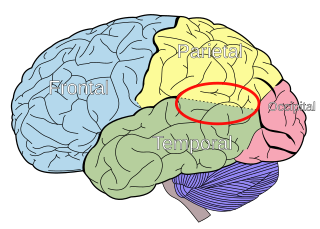
Autism is a developmental disorder characterized by difficulties with social interaction and communication and by restricted and repetitive behavior. Parents usually notice signs during the first two or three years of their child's life. These signs often develop gradually, though some children with autism reach their developmental milestones at a normal pace before worsening.

Asperger syndrome (AS), also known as Asperger's, is a developmental disorder characterized by significant difficulties in social interaction and nonverbal communication, along with restricted and repetitive patterns of behavior and interests. As a milder autism spectrum disorder (ASD), it differs from other ASDs by relatively normal language and intelligence. Although not required for diagnosis, physical clumsiness and unusual use of language are common. Signs usually begin before two years old and typically last for a person's entire life.
Anhedonia is a diverse array of deficits in hedonic function, including reduced motivation or ability to experience pleasure. While earlier definitions of anhedonia emphasized the inability to experience pleasure, anhedonia is used by researchers to refer to reduced motivation, reduced anticipatory pleasure (wanting), reduced consummatory pleasure (liking), and deficits in reinforcement learning. In the DSM-V, anhedonia is a component of depressive disorders, substance related disorders, psychotic disorders, and personality disorders, where it is defined by either a reduced ability to experience pleasure, or a diminished interest in engaging in pleasurable activities. While the ICD-10 does not explicitly mention anhedonia, the depressive symptom analogous to anhedonia as described in the DSM-V is a loss of interest or pleasure.
Depersonalization can consist of a detachment within the self, regarding one's mind or body, or being a detached observer of oneself. Subjects feel they have changed and that the world has become vague, dreamlike, less real, lacking in significance or being outside reality while looking in. It can be a disturbing experience. Chronic depersonalization refers to depersonalization-derealization disorder, which is classified by the DSM-5 as a dissociative disorder.

Catechol-O-methyltransferase is one of several enzymes that degrade catecholamines, catecholestrogens, and various drugs and substances having a catechol structure. In humans, catechol-O-methyltransferase protein is encoded by the COMT gene. Two isoforms of COMT are produced: the soluble short form (S-COMT) and the membrane bound long form (MB-COMT). As the regulation of catecholamines is impaired in a number of medical conditions, several pharmaceutical drugs target COMT to alter its activity and therefore the availability of catecholamines. COMT was first discovered by the biochemist Julius Axelrod in 1957.
Mind-blindness is a concept of a cognitive divergence where an individual is unable to attribute mental states to others. As a result of this kind of social and empathetic cognitive phenomenon, the individual is incapable of putting themselves "into someone else's shoes" and cannot conceptualize, understand or predict knowledge, thoughts and beliefs, emotions, feelings and desires, behaviour, actions and intentions of another person. Such an ability to develop a mental awareness of what is in the other minds is known as the theory of mind (ToM), and the "mind-blindness" theory asserts that children who delay in this development often are or will be autistic. In addition to autism, ToM and mind-blindness research has recently been extended to other fields such as schizophrenia, dementia, bipolar disorders, antisocial personality disorders as well as normal aging.

Neurexin (NRXN) is a presynaptic protein that helps to connect neurons at the synapse. They are located mostly on the presynaptic membrane and contain a single transmembrane domain. The extracellular domain interacts with proteins in the synaptic cleft, most notably neuroligin, while the intracellular cytoplasmic portion interacts with proteins associated with exocytosis. Neurexin and neuroligin "shake hands," resulting in the connection between the two neurons and the production of a synapse. Neurexins mediate signaling across the synapse, and influence the properties of neural networks by synapse specificity. Neurexins were discovered as receptors for α-latrotoxin, a vertebrate-specific toxin in black widow spider venom that binds to presynaptic receptors and induces massive neurotransmitter release. In humans, alterations in genes encoding neurexins are implicated in autism and other cognitive diseases, such as Tourette syndrome and schizophrenia.

The temporoparietal junction (TPJ) is an area of the brain where the temporal and parietal lobes meet, at the posterior end of the lateral sulcus. The TPJ incorporates information from the thalamus and the limbic system, as well as from the visual, auditory, and somatosensory systems. The TPJ also integrates information from both the external environment as well as from within the body. The TPJ is responsible for collecting all of this information and then processing it. This area is also known to play a crucial role in self-other distinctions processes and theory of mind (ToM). Furthermore, damage to the TPJ has been implicated in having adverse effects on an individual’s ability to make moral decisions and has been known to produce out-of-body experiences (OBEs). Electromagnetic stimulation of the TPJ can also cause these effects. Apart from these diverse roles that the TPJ plays, it is also known for its involvement in a variety of widespread disorders including amnesia, Alzheimer's disease, and schizophrenia.

Autism spectrum, also known as autism spectrum disorder (ASD) or autism spectrum condition (ASC), is a range of neurodevelopmental disorders that includes autism, Asperger syndrome and other related conditions. Individuals on the spectrum are often hyper sensitive to sensory stimuli, and present with two types of symptoms: problems in social communication and social interaction; and restricted, repetitive patterns of behavior, interests or activities. Long term issues may include difficulties in performing daily tasks, creating and keeping relationships, and maintaining a job.
Sophia Frangou is Professor of Psychiatry at the Icahn School of Medicine at Mount Sinai where she heads the Psychosis Research Program. She is a Fellow of the Royal College of Psychiatrists and Vice-Chair of the RCPsych Panamerican Division. She is a Fellow of the European Psychiatric Association (EPA) and of the American Psychiatric Association (APA). She served as Vice-President for Research of the International Society for Bipolar Disordersfrom 2010-2014. She has also served on the Council of the British Association for Psychopharmacology. She is founding member of the EPA NeuroImaging section and founding chair of the Brain Imaging Network of the European College of Neuropsychopharmacology. She is one of the three Editors of European Psychiatry, the official Journal of the European Psychiatric Association.
Childhood schizophrenia is a schizophrenia spectrum disorder that is characterized by hallucinations, disorganized speech, delusions, catatonic behavior and "negative symptoms", such as inappropriate or blunted affect and avolition with onset before 13 years of age. The term "childhood-onset schizophrenia" and "very early-onset schizophrenia" are used to identify patients in whom the disorder manifests before the age of 13.
The diagnosis of schizophrenia is based on criteria in either the American Psychiatric Association's Diagnostic and Statistical Manual of Mental Disorders, version DSM-5, or the World Health Organization's International Statistical Classification of Diseases and Related Health Problems, the ICD-10. Clinical assessment is performed by a mental health professional based on observed behavior, reported experiences, and reports of others familiar with the person. Symptoms associated with schizophrenia occur along a continuum in the population and must reach a certain severity and level of impairment before a diagnosis is made.
Autism is a variation of neural development diagnosed as impaired social interaction and communication, and by restricted and repetitive behavior. It affects an estimated 1 in 100 people. Autism is one of three recognized variations in the autism spectrum (ASDs), the other two being Asperger syndrome, which lacks delays in cognitive development and language, and pervasive developmental disorder, not otherwise specified (PDD-NOS), which is diagnosed when the full set of criteria for autism or Asperger syndrome are not met. In this article, the word autism is used for referring to the whole range of variations on the autism spectrum, which is not uncommon.
In psychiatry, stilted speech or pedantic speech is communication characterized by situationally inappropriate formality. This formality can be expressed both through abnormal prosody as well as speech content that is "inappropriately pompous, legalistic, philosophical, or quaint". Often, such speech can act as evidence for autism spectrum disorder (ASD) or a thought disorder, a common symptom in schizophrenia or schizotypal personality disorder.
The evolution of schizophrenia refers to the theory of natural selection working in favor of selecting traits that are characteristic of the disorder. Positive symptoms are features that are not present in healthy individuals but appear as a result of the disease process. These include visual and/or auditory hallucinations, delusions, paranoia, and major thought disorders. Negative symptoms refer to features that are normally present but are reduced or absent as a result of the disease process, including social withdrawal, apathy, anhedonia, alogia, and behavioral perseveration. Cognitive symptoms of schizophrenia involve disturbances in executive functions, working memory impairment, and inability to sustain attention.
Sex differences in schizophrenia are widely reported. Men and women exhibit different rates of incidence and prevalence, age at onset, symptom expression, course of illness, and response to treatment. Recent reviews of the literature suggest that understanding the implications of sex differences on schizophrenia may help inform individualized treatment and positively affect outcomes.

A self-disorder, also called ipseity disturbance, is a psychological phenomenon of disruption or diminishing of a person's sense of minimal self. The sense of minimal self refers to the very basic sense of having experiences that are one's own; it has no properties, unlike the more extended sense of self, the narrative self, which is characterized by the person's reflections on themselves as a person, things they like, their identity, and other aspects that are the result of reflection on one's self. Disturbances in the sense of minimal self, as measured by the Examination of Anomalous Self-Experience (EASE), aggregate in the schizophrenia spectrum disorders, to include schizotypal personality disorder, and distinguish them from other conditions such as psychotic bipolar disorder and borderline personality disorder.
The University of California, San Diego Performance-Based Skills Assessment (UPSA) was created by Dr. Thomas L. Patterson to provide a more reliable measure of every day functioning in patients with schizophrenia than the previously utilized methods such as self-report, clinician ratings or direct observation.







